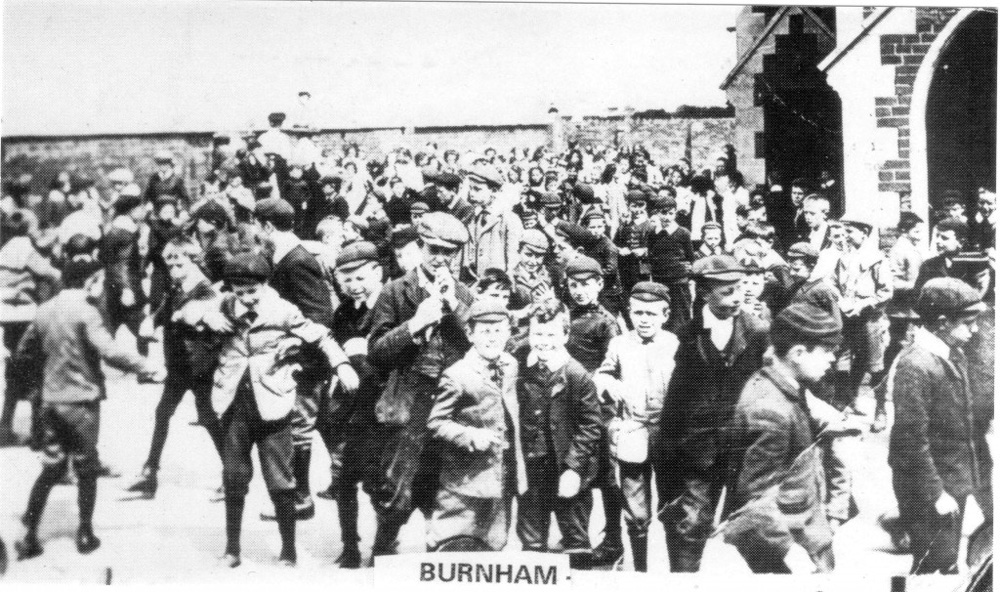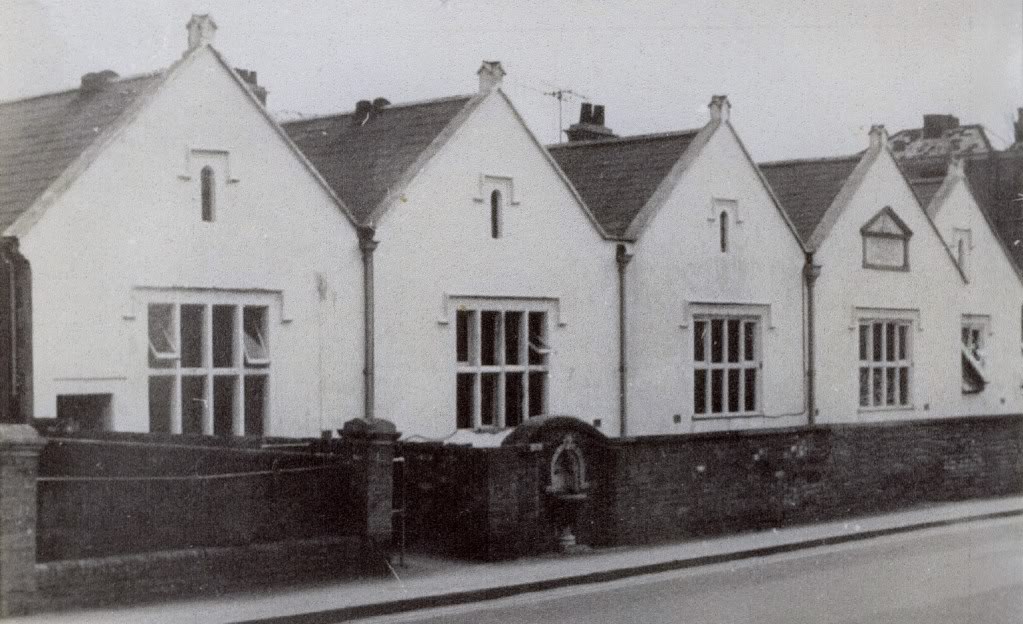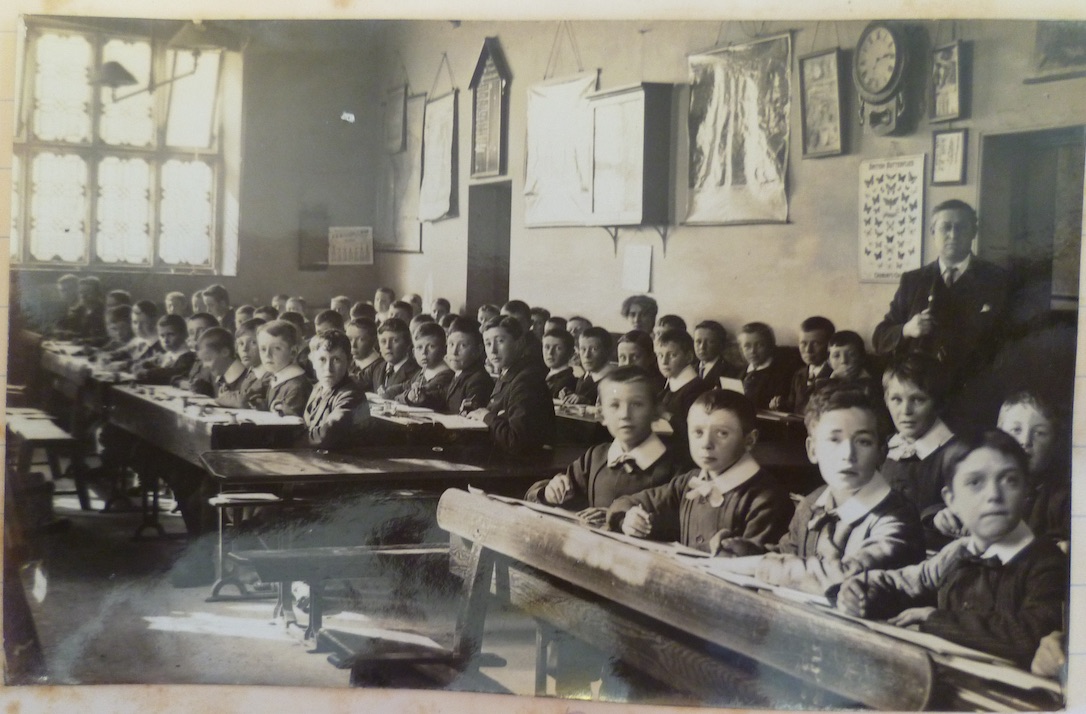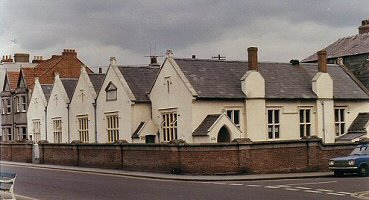The National School Society had been set up in 1811 to promote religious education. Some time after this the first Burnham National School was founded, probably at ‘Homebush’ in what is now Manor Rd, opposite Manor Gardens. By 1833 the school had only 60 pupils.
In 1855 the erection began, on the Esplanade, of a new ‘National School’ establishment, later to become St Andrew’s school. This was done at the expense of George Reed, the town’s foremost citizen of that period. A number of less wealthy residents had tried unsuccessfully for several years to raise money for a school. In 1854 George Reed gave the site on the sea front, at the top of what is now College Street, for education of children “of labouring, manufacturing and other poorer classes”. At the time the site was described as “a sand warren”. Reed also covered the cost of of building the school and master’s house (£907).

He also unexpectedly had to buy the freehold as the Dean of the Chapter of Wells (Lord of the Manor) refused to convert the land from rent paying ‘copyhold’, which would have been free or at nominal charge, as Reed had been lead to expect. A Government grant of £200 was made for fitting out and equipping the school (in 1876 a second Government grant of £124.16.10 was made towards improving facilities).
The school was opened in 1857 with 179 pupils, although a contemporary newspaper report indicates it was in use by November 1856. The 1863 log book shows a staff of master and wife (who taught needlework) and 33 children, which was soon up to 72. A fee of 2d per week was charged but waived or paid from public funds in the neediest cases. The Hours were 9-12 and 2-4.
During this time pupil attendances dropped during blackberry picking and also when there was a sale of wreckage on the jetty. Due to its exposed position the school incurred gale damage and initially the only heating was from coal fire which smoked badly in a west wind.

The original building stood where the modern flats & shops units now stand on the College Street frontage. It can be clearly seen in the picture at the top of the page. It was later extended northwards along the esplanade side of the site in 1874,1890 and 1903, after which there was no room left for further development. The name St Andrew’s was adopted in December 1906. When first built the school was bordered by flower beds, in which the children were encouraged to grow flowers. However the beds were replaced by a playground after about 30 years.

Gas was laid on to the school in 1897, before which the lack of light made work difficult during late afternoon in winter. Water had to be carried to the outside toilets for the purpose of flushing. The children took turns at this chore. heating was by open fires which, combined with poor ventilation caused suffocating smoke blow-back into the classrooms. This was alleviated by the replacement of the grate with a stove in 1890. An electricity cable was laid in 1933 but the school was not fully served by electricity until the 1950s.
In 1910 the infants classes were moved out to a temporary structure in Princess St (the site of the present library building). This was built of corrugated iron and known as the ‘Tin School’. It later became a school meals facility when the new permanent infants school was opened next door in 1914. Also in 1910 a manual instruction centre was opened for older boys in Highbridge.
St Andrew’s Junior school moved to its present purpose built premises in March 1973. The old buildings were demolished in 1980.
See more about this school on the sea front.


I remember moving from the old school to the new St Andrews, I was 8, we all walked to the new school. I have a heavy heart to see what they put in its place, but I guess that’s life.
Hello Jayne and thank you for sharing your memories of this move. Do you remember any of your school friends or school events at this sea front school? If you do please share them here as I’m sure it will prompt other pupils to send in their memories. I went to this school in the late 1950’s and have many happy memories of my time there. Playing football on the beach. The outside toilets!
John
Hi are there any photos of staff of the school in the 1950s i’m looking for a teacher either Mrs Jones or Miss Bird.
Hello Hannah,
I was a pupil here from the mid 1950’s until 1960 and don’t remember any teachers with these surnames. The earliest photos are void of names.
I do have copies of the Headmasters daily diaries from the 1860’s to the 1970’s. Unfortunately the ones for the 1950’s are missing from my collection.
John
I went to the school in the middle 60”s. The whole school had a day off after going to Church on St.Andrew’s day. I remember the toy shop across the road which also sold Airfix models. The head master was Mr. Hayward and other teachers were Mr. Crockford, Mrs.Baldwin and Mr.Speakman.
Thank you Adrian for sharing your memories of your time at this school. you may have read below that I attended here from the mid 1950’s until 1960.
Do you remember playing football on the beach ? But only tide permitting. Before play could start we had to mark out the pitch. Mrs. Baldwin was the only teacher there from your days. A very caring lady and in later years we were neighbours. Do you remember the frozen milk bottles thawing near the coke stoves and the outside toilets that froze in winter ?
Happy times I’m sure you will agree.
John
Hi Roberta,
I don’t know whether my response to John Strickland’s letter was posted but let me tell you again.
My name is Mike. I’m 87 and live in Israel. Like your late mother-in-law ( how warmly you write of her !) I was evacuated from London at the age of 4 and went to St. Andrews C of E.
I too have warm memories of Burnham, though my sister and I were fortunately joined by my parents after a short period with people in Highbridge. My father went off to war and we stayed in Burnham till 1945. I follow the daily Burnham news on line. (Old age and sentimentality!)
Hello Mike,
Thank you for your comment. I wish I had asked more about this when in earlier times. It must have been a very busy school as it accommodated children who were infants right up to leaving age of about 14, although some were employed as class assistants. Have you seen the drawing of the building from these early years on here ?
Do you have any other memories of your stay in Burnham as we love to read more about these times.
John
Hello Roberta,
I was a pupil here in the late 1950’s and have made contact with many residents who were pupils in WW2. Unfortunately very few are still with us but I will ask around and see if I can help with your question. Apparently there were so many evacuees that the local pupils were sent home in the afternoon so evacuees could attend the classes. I hope to find out more but it might take a while.
Thanks for your posting,
John
Hello John,
My name is Mike and I was an evacuee pupil between app. 1941 and 1945. Mr Holly was the Headmaster I think I’m now 87 and live in Israel, but often think of Burnham. I am even up to date with the local news because I get the daily Burnham Highbridge paper online.
Well, enjoy your cool weather cos it’s very very hot here.
Hi,
So very interesting! Is there any way of finding out if my dear late mother-in-law Jean Mary Price (her maiden name) was a pupil at this school during the time she was evacuated from Shepherds Bush, London to Burnham-on-Sea during WW2.
I would be so grateful as this may help us locate the remaining family who took such good care of her and the road perhaps where she lived for this time.
Jean spoke of Burnham with great affection, “my happy place”.
Thank you
Kind regards
Roberta Blewitt